Mongolia. That name has always stirred up visions of the untamed – Genghis Khan, camels wandering the Gobi Desert and wild horses galloping across the steppes. It’s a huge, landlocked country (17th largest in the world) about three times the size of France, squashed between China and Russia. It was immeasurably bigger between the 13th and 16th centuries, during the period of Mongol conquest under Genghis, his grandson, Kublai Khan and their descendants. At their height the Mongols ruled over the biggest empire the world has ever seen, stretching from Korea in the east to Hungary in the west and as far south as Vietnam. Even until the 20th century Mongolia was twice its present size and included a large chunk of present day Russia and Chinese Inner Mongolia.
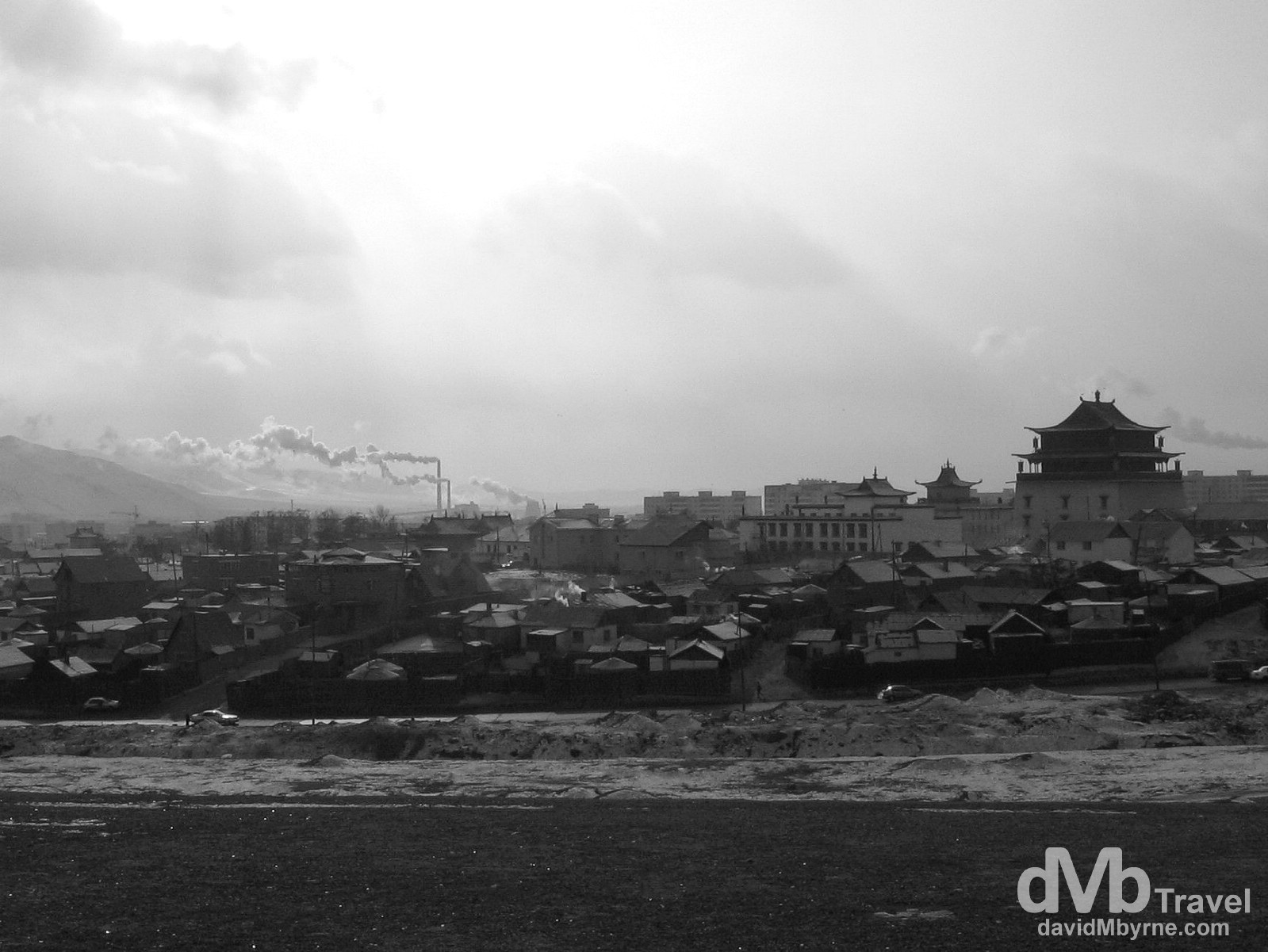
A section of Ulan Bator, the unkempt capital of Mongolia, as seen from atop Zaany Tolgoi, or Elephant’s Head, overlooking the city. The temperature up here, exposed to the biting Siberian winds from the north, was (almost) unbearable. I stayed here long enough to get a nice look at the sprawling capital and take a few pictures. That’s about all I could handle. Mongolia’s sleepy capital has the look and feel of a neglected 1950s Eastern European city. The old Soviet cars and buses are slowly being replaced by newer Korean versions and traditionally dressed men and women mingle on the city’s streets with Mongolia’s nouveaux riche. The city is dominated by communist style high-rise apartment buildings. That said, about 250,000 locals still live in the extended ger suburbs on the outskirts of town – the traditional felt gers are protected from the winds, which are especially fierce in spring, by wooden fences. Ulan Bator is built along the Tuul River and is surrounded by lovely mountains, a topography that offers good hillside views overlooking the city, views that are somewhat obscured in winter due to the pollution. Zaany Tolgoi, Ulan Bator (![]() ), Mongolia. February 15, 2006.
), Mongolia. February 15, 2006.
Mongolia
The country has had a shaky past and it’s survival as an independent nation, sandwiched between Russia and China, is miraculous. But it certainly hasn’t been smooth sailing. The empire created by Genghis and his descendants gradually weakened and by the late 17th century Mongolia had fallen under Chinese rule. 200 hundred years later, in 1911, Mongolia took advantage of a weekend China and declared its independence (China was in turmoil at the time as the last Chinese dynasty had just fallen as a result of its internal communist uprising). A treaty, signed in 1915 by Mongolia, Russia and China, granted Mongolia limited autonomy with Russian backing. The Chinese, taking advantage of Russian weakness as a result of their internal revolution (seeing a trend here?), regrouped and attacked Mongolia again in 1919. They were finally expelled in 1921 by a combined force of Mongolian and white, anti-communist, Russian troops. Not liking their situation under the anti-communist rule, the Mongolians requested the help of the Russian Bolsheviks (communist troops). They were only too glad to help and resoundingly defeated the anti-communist troops in 1922. The result was that Mongolia was declared the world’s second communist country and it was effectively under Soviet rule until the fall of the Soviet Union (USSR) in 1991. It’s been a long road but the country now has a ruling democratic coalition. But independence has cost them dearly; the country is spectacularly broke and currently suffering from a lack of support and infrastructure, something that is clear for all to see.
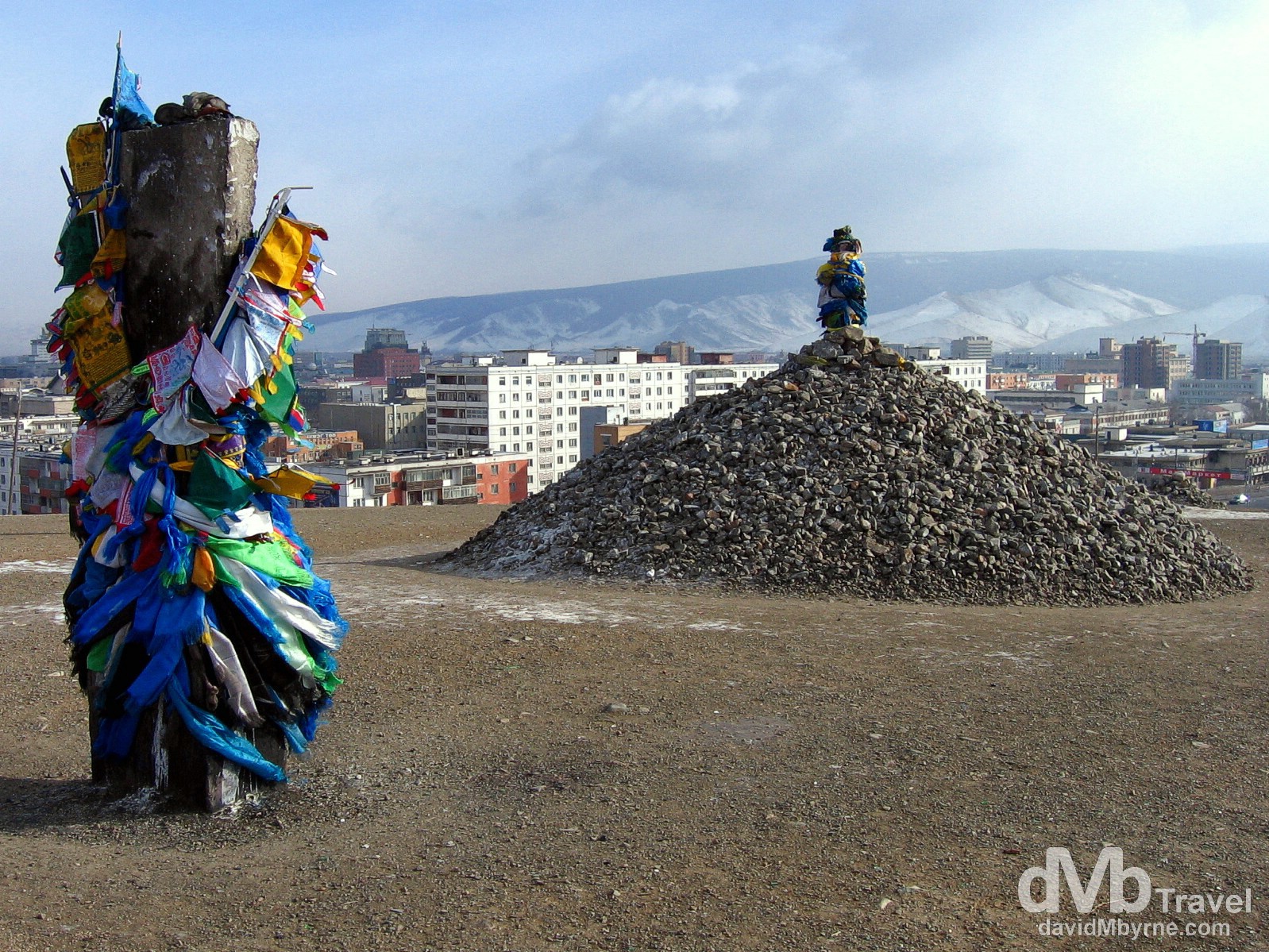
Tasgany Ovoo, a Shamanistic collection of stones, wood or other offerings to the Gods, atop Zaany Tolgoi/Elephant’s Head. The blue khatag, or scarf offering, has its roots in the blue of the sky spirit Tengger. Although Mongolians are mainly Buddhist some do practice shamanism especially in the north of the country. It was the dominant belief system of Genghis Khan and the Mongols but it has been pushed to the cultural fringes. Tasgany Ovoo, Zaany Tolgoi, Ulan Bator, Mongolia. February 15, 2006.
We do UB
We stepped off the train in Ulan Bator train station at 10 a.m. and within a few hours we had changed money, bought a train ticket for 13:35 the following day to Russia and had settled into a room in a city centre hostel. Excellent. This is more like it. It seems travelling has got so much easier since we left China. We even had the whole dorm room to ourselves. Yep, you guessed it. There aren’t too many travellers in Ulan Bator this time of year. That gave us the rest of the day and the following morning to have a look around the city. Plenty of time as it turned out. I had heard that there wasn’t a lot to see in here. Even our guidebook found it difficult to talk up the city’s ‘attractions’. The main reason to come to Mongolia is to get out of the capital and experience the nomadic herders’ way of life on the steppes of the countryside and the Gobi desert vastness. Unfortunately we hadn’t time for any of that that. A trip to the steppes was never really on the itinerary. Not at this time of year. So the predetermined (by me) list of the few sights that were of interest to us could easily be visited in the time we had in the city. The highlight of UB, as it’s commonly shortened to, is without doubt the everyday scene on the streets; the locals in traditional dress, the traders trying to make a few togrogs etc.
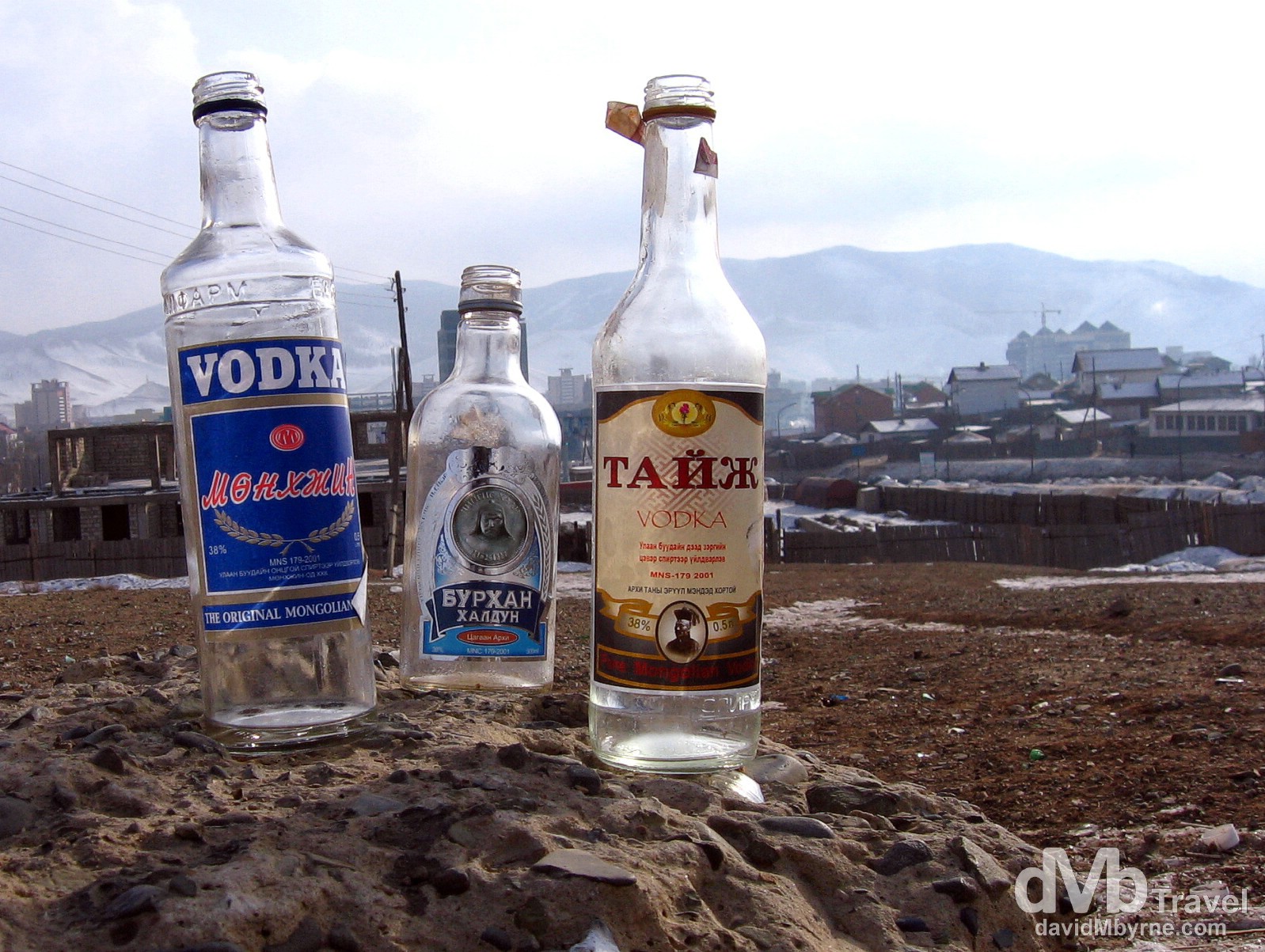
A collection of empty Vodka bottles that we found near the foot of the Zaany Tolgoi. Vodka was brought to Mongolia by the Russians and Mongolians drink a lot of it. With a depressing climate, chronic poverty and few prospects for prosperity, alcoholism is, not surprisingly, rife in the country. Mongolians can drink you under the table and men who refuse to drink arkhi (vodka) are considered wimps. With a reputation as violent drunks, it’s recommended you choose your Mongolian drinking partner carefully. We didn’t get to try any Mongolian vodka (but we’ll certainly be trying it in Russia). Not that we intended to; neither of us like the stuff anyway. We did have a few Genghis beers though. Well, what else did you expect the local brew t be called? Zaany Tolgoi, Ulan Bator, Mongolia. February 15, 2006.
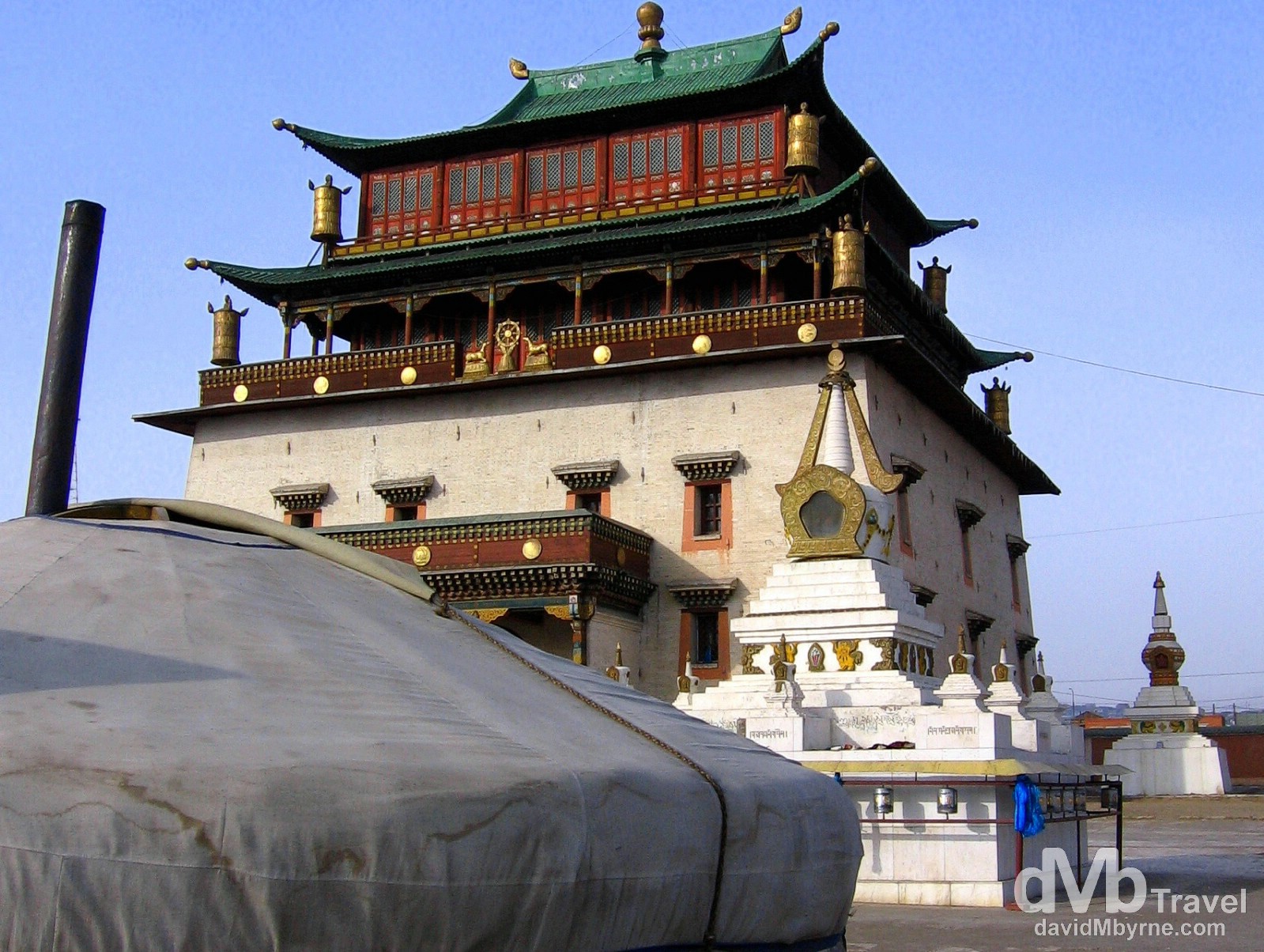
A traditional Mongolian ger fronting the Migjid Janraisig Sum (Buddhist temple) in the grounds of the Gandantegchinlen Khiid (Buddhist monastery) in Ulan Bator. This is the biggest and most important Buddhist temple in the country and the most impressive building in Ulan Bator, a city with not too many of those. Only 2 generations after Genghis Khan, the imperial court took to Buddhism. The court was persuaded that the energies at the command of the lamas were greater than those of the shaman warriors and their Gods. Since then Mongolians have always taken wholeheartedly to Tibetan Buddhism and the links between Mongolia and Tibet are old and deep – Mongolian temples & monasteries always have Tibetan names & once in a lifetime every devout Buddhist Mongolian tries to reach the Tibetan Holy City of Lhasa (the Tibetans in turn always relied on various Mongolian tribes to sustain their power). At the time of the Russian takeover in 1921, there were 110,000 lamas (monks) living in about 700 monasteries. Stalin believed the religion was anti-communist and thus beginning in the 1930’s, thousands of monks were arrested, sent to Siberian labour camps and never heard from again. Except for this monastery, which was kept as a showcase temple to impress foreigners, all monasteries were closed and ransacked and all religious worship was outlawed. Not until 1990 was freedom of religion restored. Since then, there’s been a phenomenal revival of Buddhism (and other religions) – monasteries have reopened, and even some ex-Communist Party officials have become lamas. Gandantegchinlen Khiid, Ulan Bator, Mongolia. February 15, 2006.
Mongolian Ger
A ger is a traditional circular white felt tent that is still the preferred housing for most Mongolians, even in the suburbs of the cities. The outer and innermost material of the ger is usually canvas, with an insulated layer of felt sandwiched in between (more layers in winter, fewer in summer), all supported by a collapsible wooden frame. They appear flimsy, but gers hold up amazingly well to Mongolia’s fierce winds. In the absence of electricity, candles or lamps provide lighting and there is normally a stove in the centre used for cooking and heating. Toilets are always outdoors and if showers exist at all they will normally be in a bathhouse serving a whole group of gers.
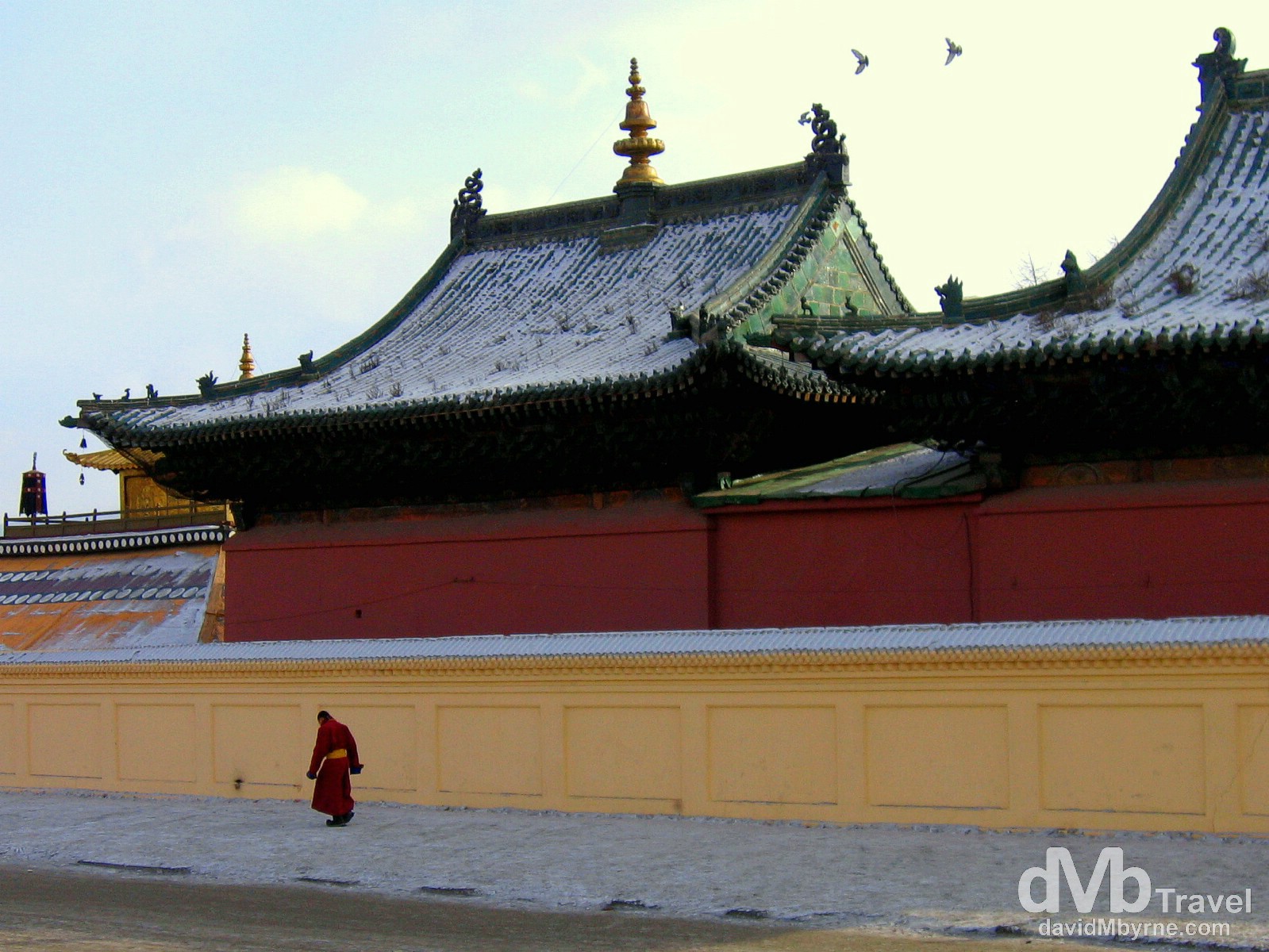
A lama (Buddhist monk) walks past the walls of the Ochirdary Sum (temple) in the grounds of Gandantegchinlen Khiid (monastery), Ulan Batar, Mongolia. February 15th 2006.
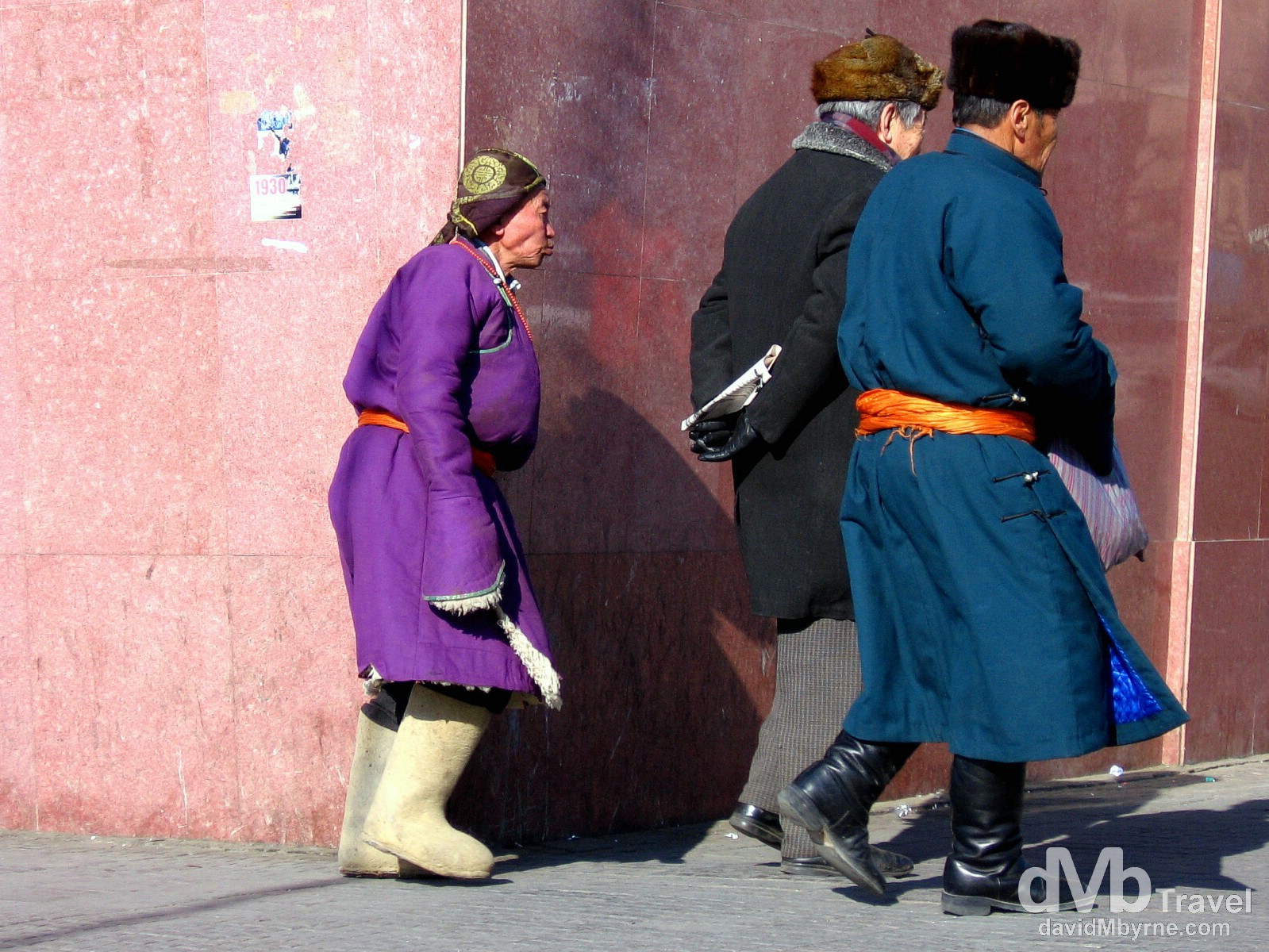
Locals walking the freezing cold streets of Ulan Bator. Many Mongolians (but always the elderly) in the city were dressed in traditional Mongolian dress. The main garment is a del, a long one-piece gown made from wool. Most Mongolians have many different dels, each suitable for a different occasions. Typically the del has a high collar, is brightly coloured, & comes with a multipurpose sash. It’s worn by men and women year round. Accompanying the del is normally gutul, high boots made from leather. They are easy to fit on – both the left and the right are the same shape – & normally the toes are upturned (although not seen in this picture). The reasons for this are varied but are more likely to be religious – the upturned end touches less ground and thus theoretically kills fewer bugs, in accordance with the Buddhist teaching about the non taking of life. In my limited experience the women seemed to wear brighter dels than the men as was certainly the case in this picture. Ulan Bator, Mongolia. February 16, 2006.
Genghis Khan
When in Mongolia, you’re never too far from a reference to Genghis Khan (‘khan’ meaning chief or leader). Before his arrival the Mongols and other nomadic peoples of Northern Asia seldom united and had little inclination to do so; they preferred instead to be nomadic, widely scattered over great areas and frequently on the move with their animals in search of pasture. They wanted to live as separate clans, united only in the face of a common threat. Genghis put an end to that – he united all the clans & led them to victory in war after war resulting in the largest empire the world has ever seen, or is likely to see. To Mongolians, Genghis Khan embodies strength, unity, law and order. He is the young king who united the warring clans and gave Mongolians a sense of direction. This is what post-communist Mongolia looks for today and Genghis Khan epitomises the historic ability to rise above confusion and uncertainty. His ubiquitous face adorns bottles of Genghis Khan vodka and beer as well as money and postage stamps. Ulan Bator’s best hotel, rock band and brewery are all named after him. Despite his reputation abroad, an understandable renewed nationalism has resulted in a reverence for the Great Khan, history’s best known Mongolian.
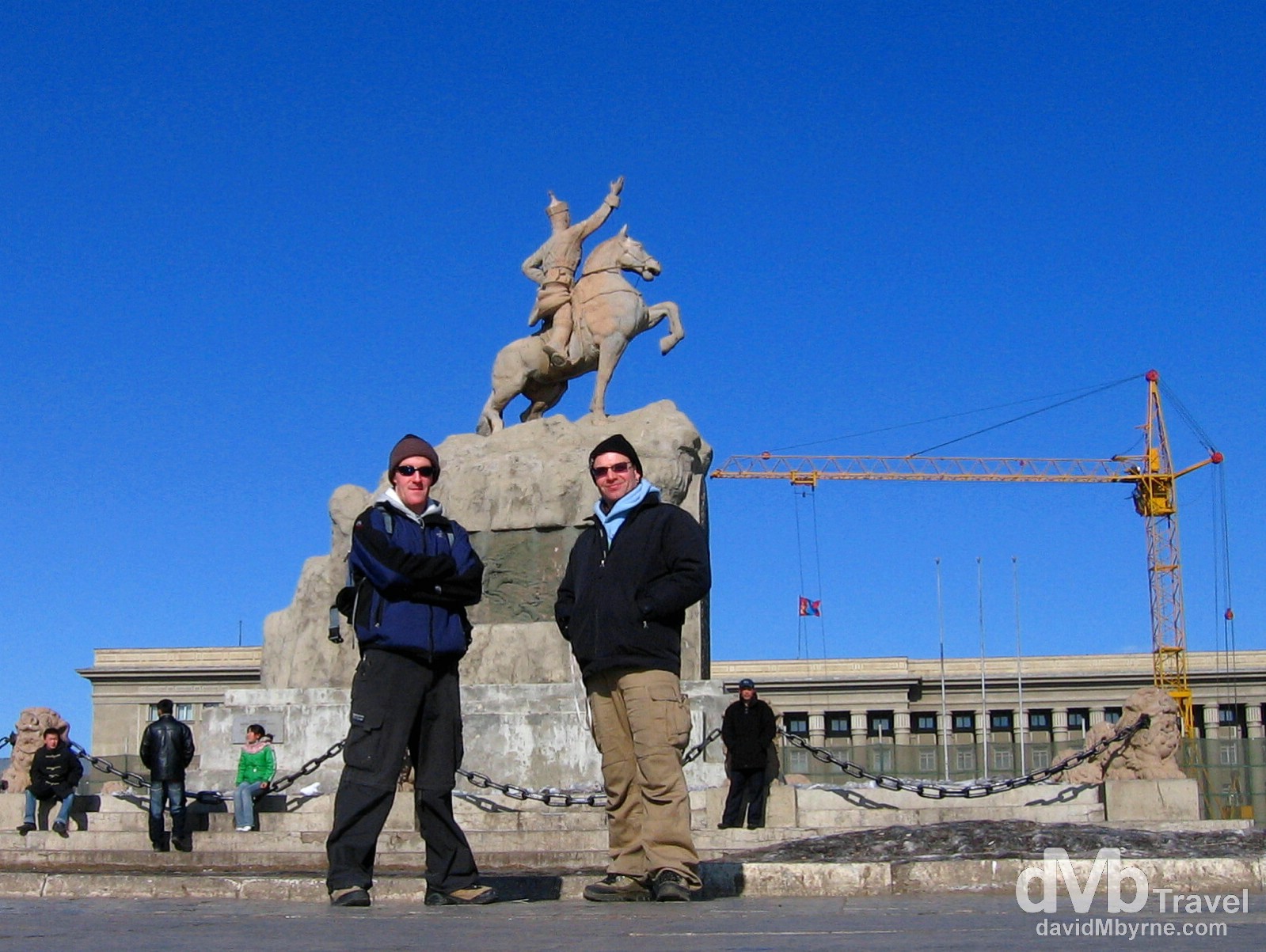
My travelling buddy Henk (right) & I fronting the Damdiny Sükhbaatar statue in Sükhbaatar Square, Ulan Bator’s main civic space which marks the centre of the city. From this spot in July 1921 Damdiny Sükhbaatar, the ‘hero of the revolution’, declared Mongolia’s independence from the Chinese. The square was also where the first of the protests which eventually led to the fall of communism were held in 1989. On normal days it’s a serene place where only pigeons and peddling photographers do much of anything. The square is surrounded by various buildings of Russian influence, the most notable of which is the grey State Parliament House, built by the Russians to their unique, bland style. Sükhbaatar Square, Ulan Bator, Mongolia. February 16, 2006.
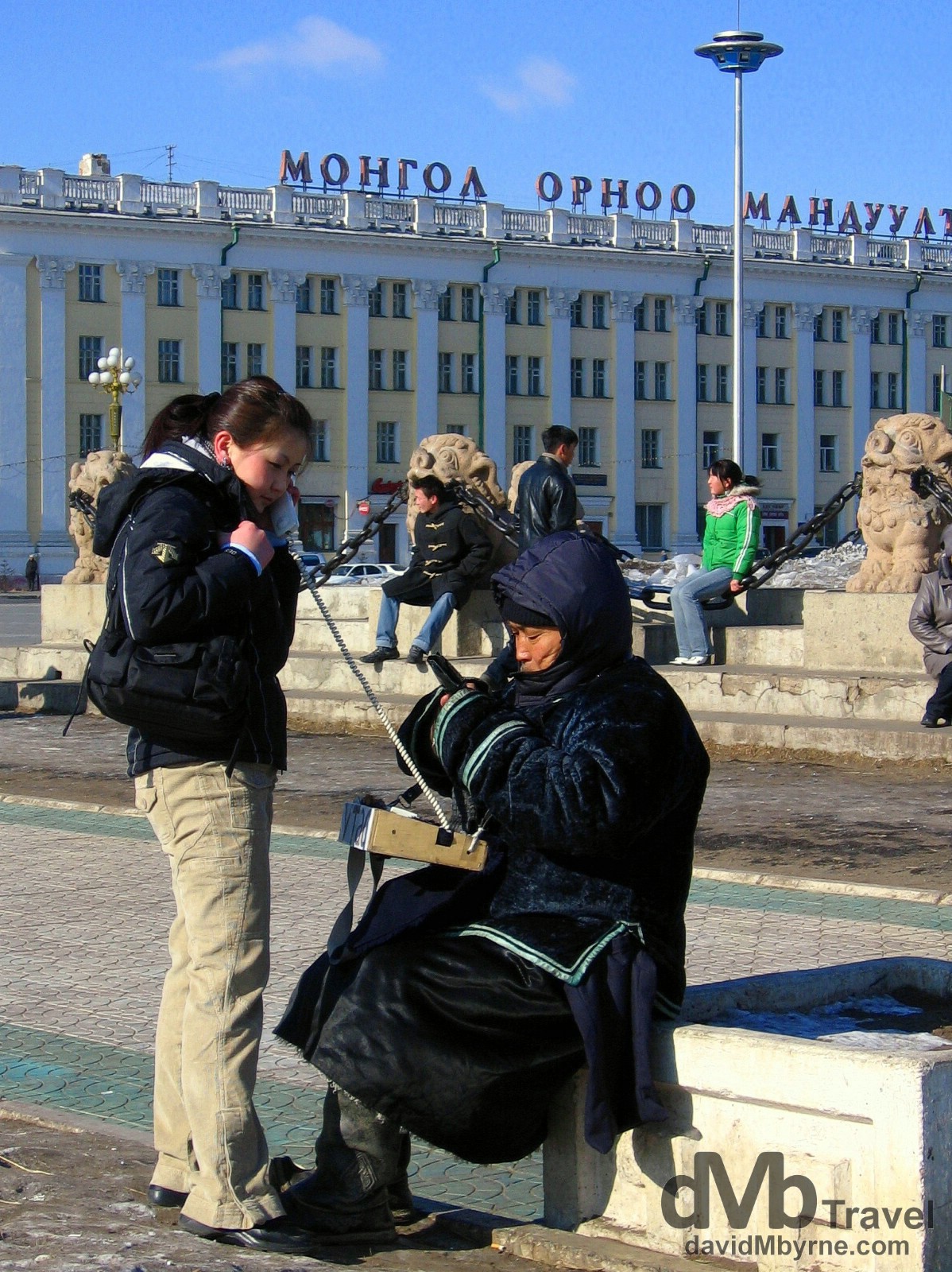
Getting connected in Sükhbaatar Square. During our first few minutes on the streets of Ulan Bator we saw numerous locals walking around with detached phone units. To our amazement we eventually discovered that this is a service. a way to make local calls. With such a bad infrastructure the country is relying on wireless communication technology to drag it, somewhat, into the future. Nearly all internet access in the country is presently over satellite links, the result of a wireless infrastructure financed by a French telecommunications company. We’ve seen very few, if any mobile/cell phones (as we know them) on the streets of the city but ample opportunities abound to make a quick call via these mobile call points. Sükhbaatar Square, Ulan Bator, Mongolia. February 16, 2006.
We’ve just spent yesterday & some of today having a look around and trying to keep warm. Mongolia has an extreme continental climate, meaning that it is so far inland that no sea moderates its climate. Only in summer does cloud cover shield the sky and with over 260 sunny days a year it’s justifiably called the ‘Land of Blue Sky’. But what that means is that winter Mongolia is cold. Very cold. So cold in fact that Ulan Bator is officially the coldest capital city in the world. And it certainly felt that way. We tried our best to wrap up but even our best efforts couldn’t prevent the stinging sensation on our faces and numbing of our jaws, two parts of our bodies we couldn’t cover. It made it uncomfortable walking around. But it was bearable. Just.
______________________________________________________________________
